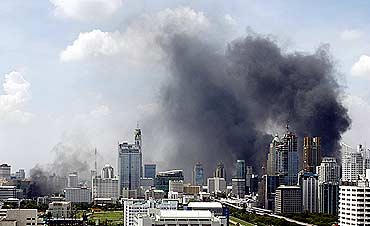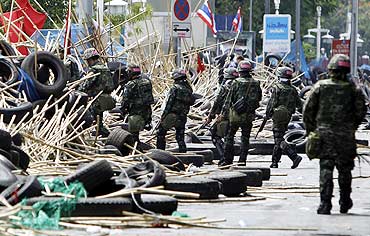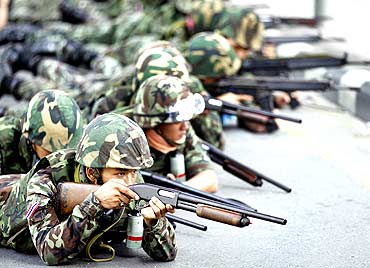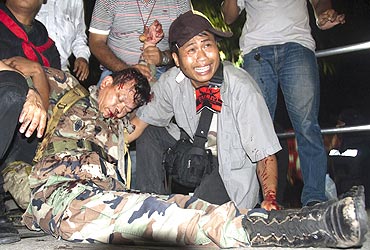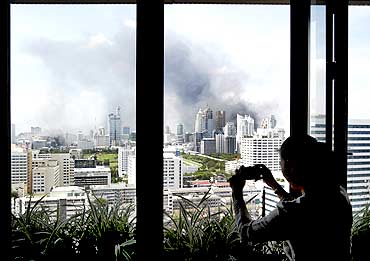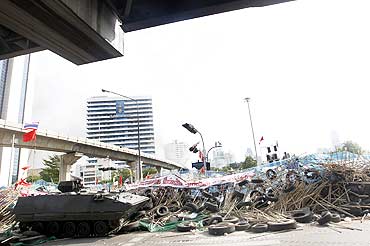 | « Back to article | Print this article |
What is happening in Thailand?
Thailand has been sliding to anarchy for the last few months with the capital Bangkok turning out to be a virtual battlefield. An FAQ:
What happened today?
On Wednesday, gun-battles broke out between the Thailand military and protesters inside the Red Shirts rally base.
According to an Associated Press photographer, three foreign journalists were shot during the army operation in central Bangkok. One of them is reportedly dead.
The assault marked the first significant push into the protest zone in the crackdown that began early today. Troops shot at least five people, including a Thai journalist, during the gunfight near the Red Shirt protesters' camp, The Age reported.
The assault comes after the Red Shirts on Tuesday agreed to hold talks with the government, which asked them to suspend their protests first.
According to latest reports, nearly 100 troops have taken up positions along the wall of central Lumpini Park and trained their guns inside.
Soldiers opened fire on medical staffers who went to the aid of the shooting victims, witnesses said. Witnesses saw several wounded protesters being carried away from the protest encampment in central Bangkok after the military moved in with weapons and armoured vehicles to secure the area, the paper said.
What are the protests all about?
The current violence is the culmination of a political strife that has been brewing ever since prime minister Thaksin Shinawatra was overthrown in a military coup in September 2006.
The protests looked like they had ended when Democrat Party leader Abhisit Vejjajiva became the prime minister in December 2008. But in March, the pro-Thaksin group launched a new wave of protests to bring down the government.
The tension has escalated in recent months as the protestors laid siege to the capital Bangkok. As security forces launched a crackdown, violence escalated, leaving many dead.
Apart from the pro-Thaksin angle, the protests are also seen as an initiative to bring in more participation for the common people -- read rural mass -- in government formation.
The Thaksin factor
Thaksin Shinawatra? Why does that name sound familiar?
Apart from numerous other controversies, including major human rights violations, Thaksin became a global name after he bought the English Premier League football club Manchester City. When he was the prime minister, he had already mounted unsuccessful attempts to buy Fulham and then Liverpool.
Critics had at that time said it was a stunt to divert attention from his political problems. In June 2007, he bought City for over $80 million, and then brought in Sven-Goran Eriksson as coach and several marquee star players to the club. In September 2008, he sold the club to an Abu Dhabi-based group for $200 million. He is tremendously popular with the rural poor, thanks to his populist healthcare and education policies.
Red Shirts take Bangkok by storm
Who are these 'Red Shirts' I keep reading about?
In the elections held 18 months after the coup, Thaksin's vote bank remained loyal, though he was in exile. His allies came to power but fell following sustained protests and unfavourable court rulings. In March 2009, Thaksin's supporters in red shirts poured into the streets of Bangkok, forming the United Front for Democracy Against Dictatorship.
Though it was mostly made of the rural poor, students and pro-democracy activists joined them. Claiming that the judiciary was biased against Thaksin, they question the legitimacy and credibility of the current government. What began as innocuous sit-in protests outside government offices quickly turned violent when they stormed the venue for ASEAN summit, forcing its cancellation.
Soon, violence erupted in Bangkok, with troops clashing with the protesters and Bangkok residents. In April, the Red Shirts called for fresh protests in Bangkok. This time, they stormed Parliament. The protests turned violent on April 11. Twenty one people, including four soldiers, were killed.
Yellow Shirts too join the fray
The Yellow Shirts, called the Peoples' Alliance for Democracy, who are bitterly opposed to Thaksin, were behind the street protests that led up to the military coup of September 2006. They were also instrumental in forcing Thaksin's allies out of power in 2008. So the score now is 2-0 in their favour.
If the Red Shirts are mostly rural poor, the Yellow Shirts comprise royalists, businessmen and the urban middle-class. They wear yellow because it is the Thai King's colour.
Media-baron Sondhi Limthongkul and General Chamlong Srimuang are seen as the leaders of this outfit. In 2006, as the Yellow Shirts shut down the capital, the army ousted Thaksin.
Things were normal for a few months, but turned volatile after Thaksin's allies won the December 2007 elections to form the government. In May 2008, the Yellow Shirts restarted protests, doing more or less the same things that the Red Shirts are doing now, and even succeeded in getting the Democrats to power. Now, with the Red Shirts relaunching their protests, the Yellow Shirts have threatened to retaliate.
Going from bad to worse
What is the current situation?
On May 17, the government extended its deadline for protestors to leave their camp in the heart of Bangkok. The government said its main focus was to convince women and children to leave the site. After the government rejected the protestors' demand for United Nations intervention, the leaders said the government should at least withdraw the troops to ease tensions. The protest is now threatening to spill outsde the capital to poorer, rural regions.
Red Shirt protestors determinedly continued to resist security forces, despite the government having declared the rally area as a 'live-fire' zone earlier.
The establishment was also mulling the imposition of a curfew, but there has been no such injunction yet.
Making things worse, Red Shirt leader General Khattiya Sawasdiphol, also known as 'Seh Daeng,' was pronounced dead on Monday.
He fell prey to a soldier's bullet even as he was speaking to reporters at the protest venue last Thursday. He finally succumbed to the gunshot wound that went through his head on Monday morning.
So what happens now?
Will there be more violence?
If the army can take the streets back soon, chances are that the protests will fizzle out. If it does not, the Red Shirts have a good chance of increasing their hold, and taking the protests to others parts of the country. Some say it could even lead to a civil war.
Observers maintain that though the Red Shirts and the government seem to be in an eyeball-to-eyeball confrontation, back channels of communication are still open. The army's withdrawal will be detrimental to the government's interest and is not bound to happen any time soon. But if the violence continues, the government would be forced to agree for a compromise.
Is there a way out? Can I take a vacation there?
What is the way out?
Meanwhile, in a significant development that could lead to an end of the impasse, the chairman of the United Front for Democracy against Dictatorship, Veera Musikhapong, is now engaged in a peace dialogue with the government.
The UDD's demands include pulling back of troops, suspending use of force and permitting a truce.
"Veera had sent a letter to UDD core leaders insisting that he is still performing his duty as a co-leader and is now discussing with representatives of the government how to rapidly end political crisis," the Bangkok Post quoted UDD co-leader Weng Tojirakarn as saying.
Weng also refuted government allegations of war weapons being used by agitators, however he conceded that the Red Shirt leaders have no control over their zealous supporters outside of the Ratchaprasong intersection area.
Is there any Indian connection here?
Bangkok is the Asian medical tourism hub. With several countries like the United States, Canada, the United Kingdom, and Australia having issued advisories against traveling to Thailand, the medical tourists are the most hit. With Bangkok not a feasible place for the time being, reports said patients will be forced to look toward Indian surgeons and hospitals.
Can I go ahead with my Thailand vacation?
Most countries -- Western and Asian -- have issued travel advisories cautioning its citizens from traveling to Bangkok. Most parts of the rest of the country are still safe, and not many countries have issued any advisory about the rest of the country.
